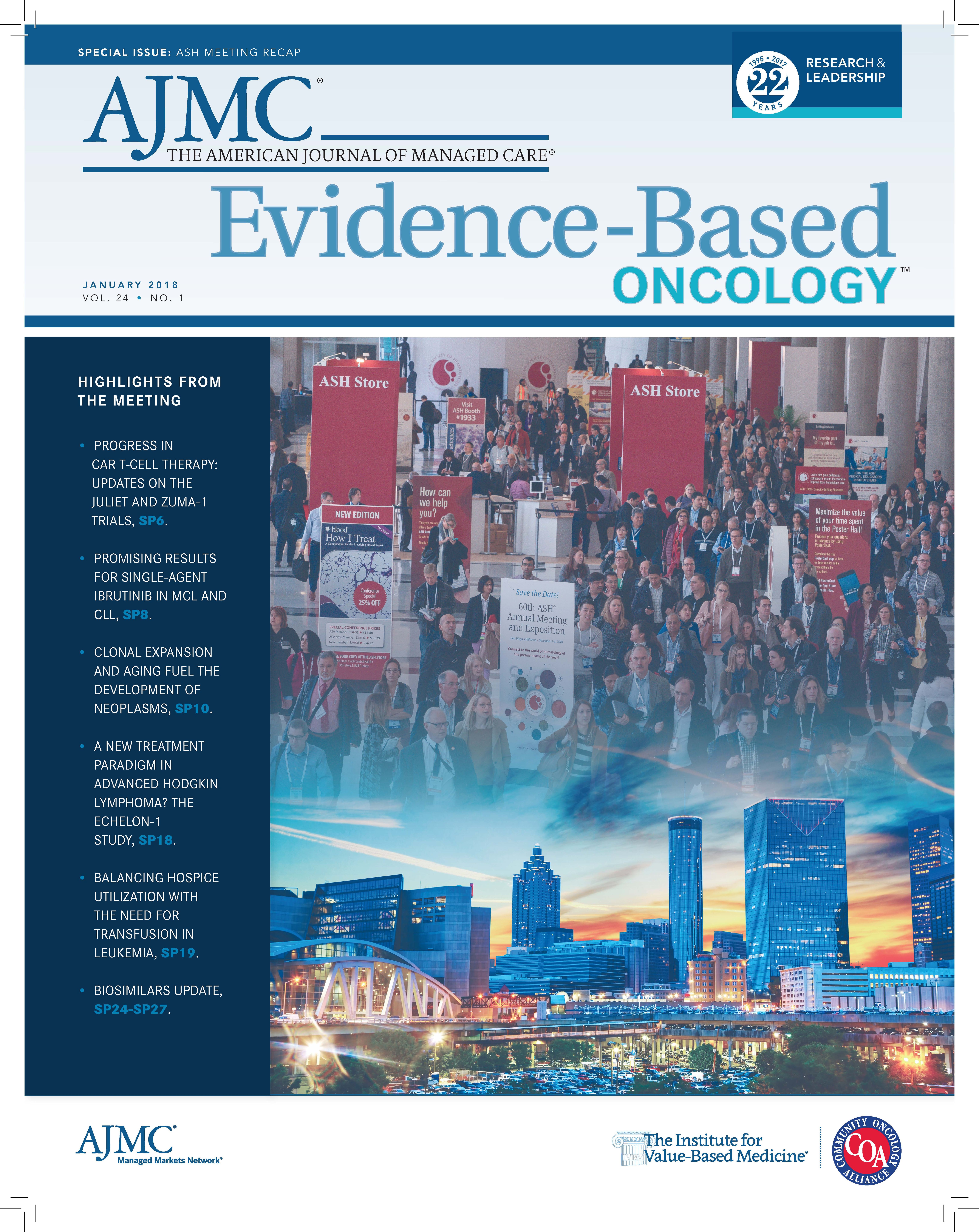Publication
Article
Evidence-Based Oncology
New Treatment Paradigm Supersedes ABVD in Advanced Hodgkin Lymphoma: The ECHELON-1 Study
Author(s):
Coverage from the 59th Annual Meeting and Exposition of the American Society of Hematology, December 9-12, 2017.
Phase 3 results from the ECHELON-1 study, presented at the 59th Annual Meeting & Exposition of the American Society of Hematology, showed superior modified progression-free survival (mPFS) after adding the modified anti-CD30 antibody brentuximab vedotin to doxorubicin, vinblastine, and dacarbazine (AVD) in patients with advanced Hodgkin lymphoma (HL). This presents a significant change in the standard frontline regimen of doxorubicin, bleomycin, vinblastine, and dacarbazine (ABVD), which has not been modified for over 40 years, since it was first described, according to presenting author Joseph M. Connors, MD, medical oncologist, BC Cancer Agency, University of British Columbia, Canada.
About 30% of patients with advanced stage HL have relapsed or refractory disease following frontline ABVD. Add to that the pulmonary toxicity associated with
bleomycin, which may then be dropped off from later cycles of chemotherapy.
Connors then shared the phase 2 results of ECHELON-1, which documented a 3-year PFS of 58% and a 3-year overall survival (OS) of 73%.1 “Of the 34 patients who had
a complete response, 47% were progression free at 53 months,” he added. “Several studies have demonstrated that intensifying the ABVD regimen in these advanced-stage patients does not provide any survival advantage,” Connors said. Therefore, the considerations for their study design for the new regimen included:
• OS advantage
• Duration of follow-up
• Impact on fertility and short- and long-term organ damage
• Economics, especially in the context of supportive care such as the need for growth factors
Patients enrolled in the open-label, global (218 study sites in 21 countries) ECHELON-1 study were randomized 1:1 to receive A+AVD (brentuximab vedotin 1.2 mg/kg, doxorubicin 25 mg/m2, vinblastine 6 mg/m2, and dacarbazine 375 mg/m2) (n = 664) or ABVD (doxorubicin 25 mg/m2, bleomycin 10 U/m2, vinblastine 6 mg/m2, and dacarbazine 375 mg/m2) (n = 670) on days 1 and 15 of up to six 28-day cycles. “Patients with a [positron emission tomography] (PET) scan Deauville score of 5 after cycle 2 could switch to alternative therapy at the treating physician’s discretion,” Connors said.
Patients (n =1334) were stratified by region (Americas vs Europe vs Asia) and International Prognostic Score (0-1 vs 2-3 vs 4-7). Toward the end of the study, the independent data monitoring committee recommended primary prophylaxis with granulocyte colony-stimulating factor (G-CSF) for newly randomized patients receiving A+AVD based on a higher incidence of febrile neutropenia in that arm. The primary end point was mPFS (defined as time to progression, death, or evidence of incomplete response followed by subsequent anticancer therapy) determined by independent review facility assessment.
At a median follow-up of 24.9 months (range, 0-49.3), the 2-year rate of mPFS was 82.1% in the A+AVD group (95% CI, 78.7-85.0) compared with 77.2% (95% CI, 73.7-80.4) in the ABVD group. The hazard ratio for progression, death, or modified progression, 0.77 (95% CI, 0.60 to 0.98; P = .03), corresponded with a 23% risk reduction.
Fewer patients in the A+AVD arm (n = 117) had events of progression, death, or modified progression compared with the ABVD arm (n = 146). The trial documented the following
secondary end points for A+AVD compared with the ABVD arm:
• Complete response rate at the end of the randomized regimen: 73% versus 70% (P = .22)
• Objective response rate at the end of the randomized regimen: 86% versus 83% (P = .12)
• PET Deauville score 1 or 2 after frontline therapy: 85% versus 80% (P = .03)
• PET Deauville score of 1, 2, or 3 after cycle 2: 89% versus 86% (P = .18)
Neutropenia was reported in 58% of patients receiving A+AVD and 45% receiving ABVD (febrile neutropenia in 19% and 8%, respectively), but discontinuations due to neutropenia or febrile neutropenia were low in both arms. Grade ≥3 infections were more common in the A+AVD arm (18%) than the ABVD arm (10%). In patients receiving A+AVD, primary prophylaxis with GCSF (n = 83) reduced febrile neutropenia from 19% to 11% and grade ≥3 infections and infestations from 18% to 11%. Peripheral neuropathy (PN) occurred in 67% of patients receiving A+AVD and 43% receiving ABVD; 67% of patients experiencing PN in the A+AVD arm had resolution or improvement of PN at last followup. Pulmonary toxicity was more frequent and more severe with ABVD (grade ≥3: 3% ABVD vs <1% A+AVD).
There were 28 deaths in the A+AVD group and 39 in the ABVD group; interim 2-year OS was 96.6% for the A+AVD group (95% CI, 94.8-97.7) and 94.9% for the ABVD group (95% CI, 92.9-96.4).
A+AVD had superior efficacy to that of ABVD in the treatment of patients with advanced-stage HL, with a 4.9 percentage—point lower combined risk of progression, death, or non-complete response at 2 years, the results of the study showed. “This establishes A+AVD as a new frontline option for patients with advanced-stage HL,” Connors concluded. Reference
1. Connors JM, Jurczak, W, Straus DJ, et al. Brentuximab vedotin plus doxorubicin, vinblastine, dacarbazine (A+AVD) as frontline therapy demonstrates superior modified progression-free survival versus ABVD in patients with previously untreated stage III or IV Hodgkin lymphoma (HL): the phase 3 Echelon-1 study. In: Proceedings from the 59th Annual Meeting & Exposition of the American Society of Hematology; December 9-12, 2017; Atlanta, GA. Abstract 6. ash.confex.com/ash/2017/webprogram/Paper105589.html.







